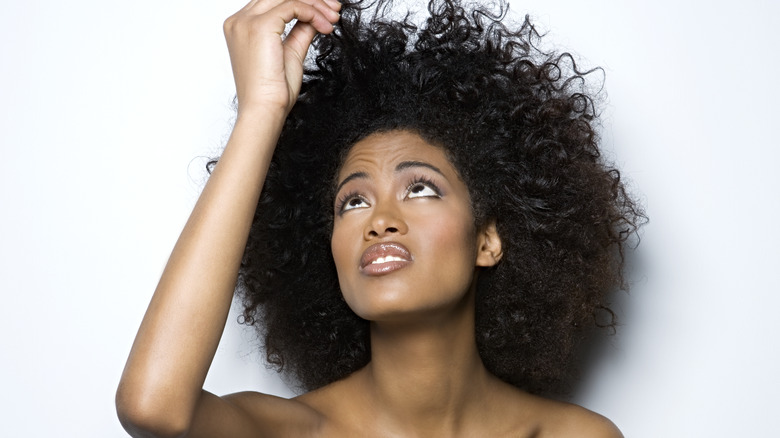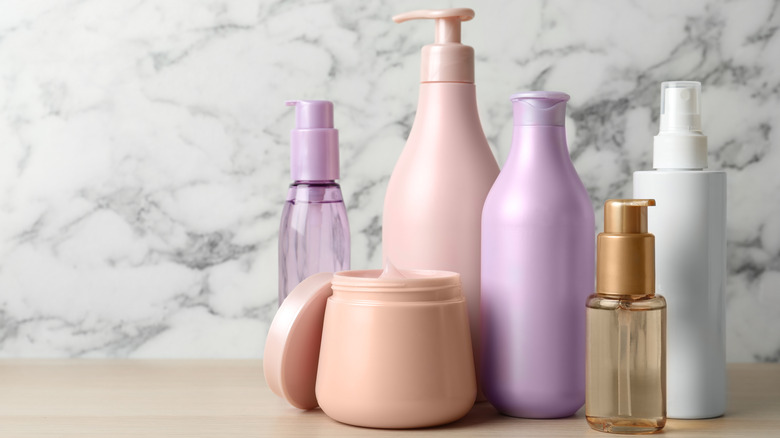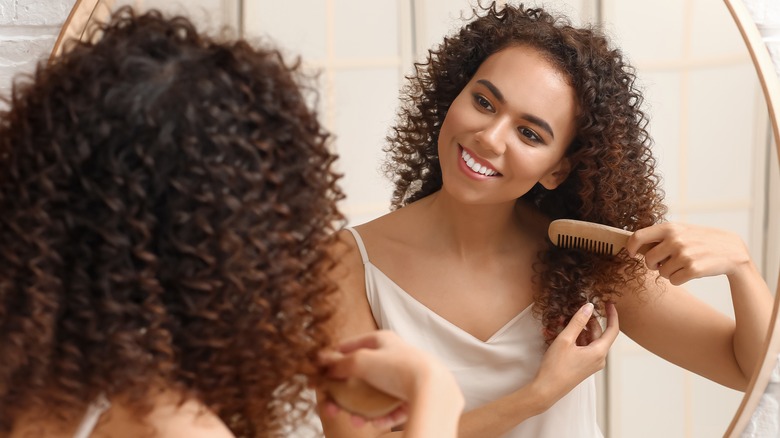Bringing Your Natural Curls Back To Life After Being Damaged Isn't Impossible. Here's Why
Let's face it: our hair is susceptible to a lot of damage, especially when we undergo certain treatments or apply heat on a regular basis. If you're lucky enough to have lush, natural curls, you might be yearning for those pre-damage days. Whether you had a hair-lightening mishap or a heat treatment gone wrong, your natural curls can still be brought back to life. First, it helps to understand why curly hair is so fragile.
As Prevention explains, curly hair is notorious for being drier than other types, as well as highly susceptible to breakage. For this reason, it can be challenging to manage on a regular basis. Once the damage has occurred, you might become even less motivated to style it.
There are many reasons why your curly locks may have become damaged. Product build-up, for instance, might be preventing your hair from absorbing moisture, according to NaturallyCurly. If you don't regularly deep condition your hair, you may be leaving it susceptible to frizz, dryness, and breakage. Permanent dye and bleaching can also cause severe damage to your curls. If you wear your hair for an extended period of time in a protective style, such as cornrows, you might prevent it from naturally breathing and shedding. Here is what you need to know about bringing your natural curls back to life post-damage.
How to bring your curls back to life
The first step to restoring your natural curls once they've been put through the wringer is cutting back on your shampooing, per Treatwell. Shampoo is notorious for stripping hair of its natural oils, and curly hair, in particular, needs as much moisture as possible. Opt for a simple rinse while in the shower if your hair feels unclean, or use a light conditioner.
Next, steer clear of heat styling entirely until you fully rehab your natural curls. Heat can potentially cause permanent damage to curly hair by altering its structure. Furthermore, it causes problems, such as frizz and brittleness, which can be a curly-haired woman's worst enemies.
Finally, Curlfit recommends investing in the right products for your hair type and using them regularly for restoration. For example, using a protein treatment weekly can help strengthen your hair, especially if you're suffering from damage due to a process like bleaching. Adding a restorative cream or hair oil to your routine can be beneficial as well, particularly because curly hair needs as much moisture as possible. While rehabbing your curls, don't forget to avoid tight hairstyles that tug on your locks. Styles, such as braids, can be too much for fragile hair and even result in hair loss. While you may cringe at the thought of being seen in public during your curl restoration process, the end result will be worth it.
Preventing future damage to your curls
Once you've rehabbed your curls, you can avoid future damage by taking preventative measures, and some of this will begin with altering your haircare routine. Healthline highlights the importance of integrating curly hair-specific products into the mix. While browsing the haircare aisle at the store, look for shampoos and conditioners that include ingredients, such as aloe vera, keratin, and shea butter. All of these can help your curls retain moisture.
Another product you can add to your arsenal is a pre-shampoo treatment, which can be especially beneficial if you have coarse curls. Coarse hair, in general, often loses moisture more quickly. By using a pre-shampoo treatment, you can protect your locks from any natural oils that may be stripped during your wash. Just remember to give it at least 30 minutes to work its magic before rinsing, per Healthline.
Finally, consider changing the hairbrush you use. A high-quality brush can help your natural oils spread evenly from root to tip. Women's Wear Daily recommends boar bristle and paddle brushes for styling this hair type. Post-shower, go with a comb for detangling or a wet brush with flexible bristles to minimize tugging. Alternatively, you can skip brushing altogether and let your natural curls flow freely. At the end of the day, the goal should be to rock your curls confidently — no hair damage necessary.


